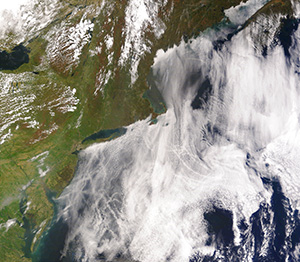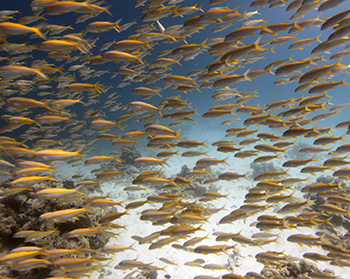
Promoting peace and human security on our planet will require us to overcome a multitude of obstacles, maintaining environmental sustainability not least among them.
 Promoting peace and human security on our planet will require us to overcome a multitude of obstacles, maintaining environmental sustainability not least among them. History shows us that human ingenuity is well equipped to handle many of these challenges, both those that we can predict and those that we can’t. But at what point will we reach the end of our ability to adapt? Dr. Ruth DeFries, Professor of Sustainable Development at Columbia University, has researched this topic at length. In her recently released book, The Big Ratchet, DeFries explores the historical cycles of technology and development with a focus on the need to feed an ever-growing population. She brought her knowledge of the interplay between human development and the environment to the OEF Forum on Peace in the 21st Century.
Promoting peace and human security on our planet will require us to overcome a multitude of obstacles, maintaining environmental sustainability not least among them. History shows us that human ingenuity is well equipped to handle many of these challenges, both those that we can predict and those that we can’t. But at what point will we reach the end of our ability to adapt? Dr. Ruth DeFries, Professor of Sustainable Development at Columbia University, has researched this topic at length. In her recently released book, The Big Ratchet, DeFries explores the historical cycles of technology and development with a focus on the need to feed an ever-growing population. She brought her knowledge of the interplay between human development and the environment to the OEF Forum on Peace in the 21st Century.
But what exactly is the role of the environment and sustainability in promoting peace? DeFries reminds us that a secure environment is foundational for peace because people “can be peaceful and happy when their environment is conducive.” However, the opposite is also true, meaning that environmental problems cause discord that threatens peace. We are dependent on the environment for our basic needs and our way of life, whether that is food, fuel, or the various rare minerals required to manufacture our smartphones (need may be a relative term here). But our needs are placing ever-increasing pressure on the environment that could cause problems for our future well-being.
 We are today encountering many of these risks. Reports on the changing climate, such as the 2014 National Climate Assessment and the Fifth Assessment Report of the Intergovernmental Plan on Climate Change, paint an ominous picture of the future with increasing natural disasters and greater need for countries and communities to adapt to the impacts of a changing climate. It is true that climate change is unlikely to be a direct cause of war, and for those directly facing conflict it is unlikely that climate change is a primary concern. Nevertheless climate change will only make it harder for vulnerable communities to overcome poverty, pandemic disease, famine, and endless other natural and manmade disasters, as was outlined in the US Department of Defense’s 2014 Climate Change Adaptation Roadmap. This “threat multiplier”, as it was described by the US Department of Defense, has the potential to aggravate violence and conflict if it is not met with coordinated action.
We are today encountering many of these risks. Reports on the changing climate, such as the 2014 National Climate Assessment and the Fifth Assessment Report of the Intergovernmental Plan on Climate Change, paint an ominous picture of the future with increasing natural disasters and greater need for countries and communities to adapt to the impacts of a changing climate. It is true that climate change is unlikely to be a direct cause of war, and for those directly facing conflict it is unlikely that climate change is a primary concern. Nevertheless climate change will only make it harder for vulnerable communities to overcome poverty, pandemic disease, famine, and endless other natural and manmade disasters, as was outlined in the US Department of Defense’s 2014 Climate Change Adaptation Roadmap. This “threat multiplier”, as it was described by the US Department of Defense, has the potential to aggravate violence and conflict if it is not met with coordinated action.
 Climate change is not the only environmental risk that people face. Food insecurity, which is directly affected by the health of the environment, also has the potential to aggravate conflict. Discussion of food security often circles back to agriculture, but the oceans are another important source of food, especially of protein, for developing countries. According to the Marine Stewardship Council, approximately one billion people living in developing countries rely on fish as their main source of protein. But the ongoing availability of fish at current levels is uncertain. The vast majority of global fisheries are either fully fished or overfished, as was reported in the FAO’s 2014 report on the State of World Fisheries and Aquaculture. This same report states that overfishing not only causes negative ecological consequences, it also reduces fish production, which further leads to negative social and economic consequences.
Climate change is not the only environmental risk that people face. Food insecurity, which is directly affected by the health of the environment, also has the potential to aggravate conflict. Discussion of food security often circles back to agriculture, but the oceans are another important source of food, especially of protein, for developing countries. According to the Marine Stewardship Council, approximately one billion people living in developing countries rely on fish as their main source of protein. But the ongoing availability of fish at current levels is uncertain. The vast majority of global fisheries are either fully fished or overfished, as was reported in the FAO’s 2014 report on the State of World Fisheries and Aquaculture. This same report states that overfishing not only causes negative ecological consequences, it also reduces fish production, which further leads to negative social and economic consequences.
As with climate change, there is no simple solution to the risks associated with food insecurity. Multi-stakeholder coordination will be needed to address these problems at the community, state and international level. As one example of these efforts, OEF Research's sister program, Secure Fisheries, is working with local and international partners to provide Somalis with research and analysis designed to promote sustainable fisheries as a means to safeguard a crucial natural resource and potential driver of Somalia’s future economic stability.
 So what does this mean for the future? DeFries provides a refreshingly optimistic perspective. She looks not just at the risks we face, but also at the potential for human ingenuity and proactivity to overcome them. DeFries closes her book by saying “Humanity is still, and will always be, learning to live with the massive transformations our ingenuity has wrought.” As we work to continue the positive trends towards peace in the 21st century, we will have to continue to adapt to the interplay between our changing needs and the changing environment, and remember the role that the environment plays in those efforts.
So what does this mean for the future? DeFries provides a refreshingly optimistic perspective. She looks not just at the risks we face, but also at the potential for human ingenuity and proactivity to overcome them. DeFries closes her book by saying “Humanity is still, and will always be, learning to live with the massive transformations our ingenuity has wrought.” As we work to continue the positive trends towards peace in the 21st century, we will have to continue to adapt to the interplay between our changing needs and the changing environment, and remember the role that the environment plays in those efforts.
This brings us back to DeFries’ point: “The idea of a peaceful planet is within the realm of reality. If you look at the trends, we're going in that direction. Of course, we can never be complacent. We have to work to continue those trends, but this could be the century of peace.”
Article Details
Published
Written by
Topic
Program
Content Type
Opinion & Insights